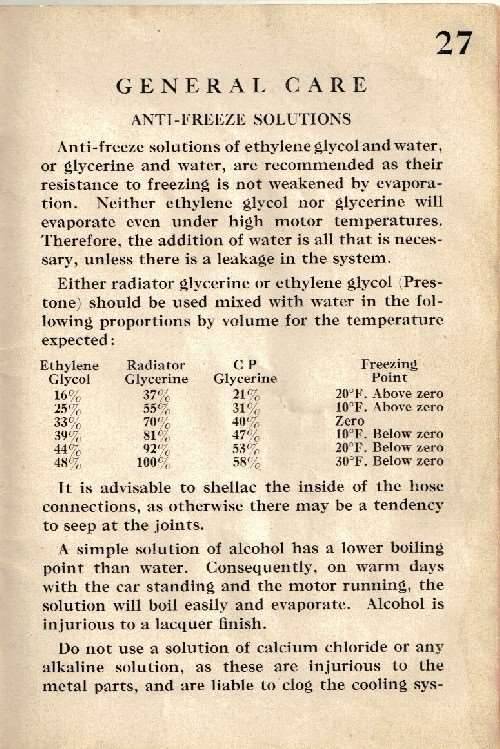Re: water/antifreeze
Posted by Owen_Dyneto On 2012/12/31 9:27:26
There were 3 types of antifreeze in use in 1935, methanol, glycerine, and ethylene glycol, all to be mixed with appropriate amounts of water. Although methanol had been the standard for many years, it had the disadvantage of evaporating due to it's low boiling point (about 160 F) and ethylene glycol rapidly became the favored material though methanol was still in use for a few years after WWII, most commonly as Zerone, the companion product to Zerex which was ethylene glycol based.
Doesn't sound like your friend knows much about cars, perhaps he should at a minimum buy a reprint of the owner's manual which among other things does discusses the various types of antifreeze. And yes, you add it at the radiator cap and then run the engine for a few minutes to circulate and mix it.
As to the comment that I have to think that these cars were routinely tested by Packard for temperatures below zero, that's no doubt true, but NOT without antifreeze. Water expands slightly just below the freezing point and that's the reason it cracks blocks when frozen solid. And you can crack blocks by adding cold water too rapidly to a very overheated engine - those cracks usually occur at the exhaust valve seats and can progress across and down the cylinder walls whereas freeze cracks usually occur at the water jackets.
Page from the 34 Eight owner's manual attached. The corresponding page in the 35 and 36 owner's manual is essentiall the same except it eliminates the reference to C.P. (chemically pure) glycerine.
Attach file:
 (176.72 KB)
(176.72 KB)

Doesn't sound like your friend knows much about cars, perhaps he should at a minimum buy a reprint of the owner's manual which among other things does discusses the various types of antifreeze. And yes, you add it at the radiator cap and then run the engine for a few minutes to circulate and mix it.
As to the comment that I have to think that these cars were routinely tested by Packard for temperatures below zero, that's no doubt true, but NOT without antifreeze. Water expands slightly just below the freezing point and that's the reason it cracks blocks when frozen solid. And you can crack blocks by adding cold water too rapidly to a very overheated engine - those cracks usually occur at the exhaust valve seats and can progress across and down the cylinder walls whereas freeze cracks usually occur at the water jackets.
Page from the 34 Eight owner's manual attached. The corresponding page in the 35 and 36 owner's manual is essentiall the same except it eliminates the reference to C.P. (chemically pure) glycerine.
Attach file:
 (176.72 KB)
(176.72 KB)
This Post was from: https://packardinfo.com/xoops/html/modules/newbb/viewtopic.php?post_id=115255